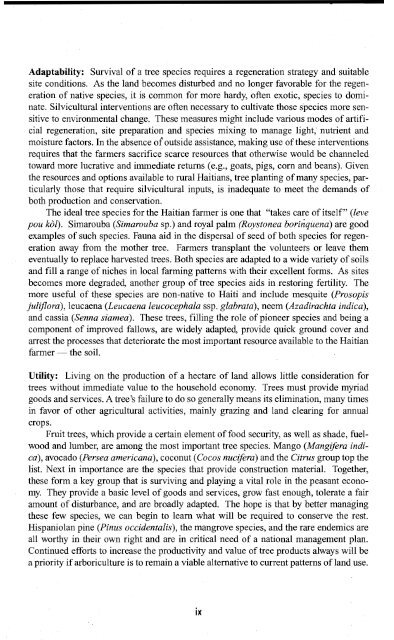Bwa-yo - Société Audubon Haiti
Bwa-yo - Société Audubon Haiti
Bwa-yo - Société Audubon Haiti
Create successful ePaper yourself
Turn your PDF publications into a flip-book with our unique Google optimized e-Paper software.
Adaptability: Survival of a tree species requires a regeneration strategy and suitable<br />
site conditions. As the land becomes disturbed and no longer favorable for the regeneration<br />
of native species, it is common for more hardy, often exotic, species to dominate.<br />
Silvicultural interventions are often necessary to cultivate those species more sensitive<br />
to environmental change. These measures might include various modes ofartificial<br />
regeneration, site preparation and species mixing to manage light; nutrient and<br />
moisture factors. In the absence ofoutside assistance, making use ofthese interventions<br />
requires that the farmers sacrifice scarce resources that otherwise would be channeled<br />
toward more lucrative and immediate returns (e.g., goats, pigs, corn and beans). Given<br />
the resources and options available to rural <strong>Haiti</strong>ans, tree planting ofmany species, particularly<br />
those that require silvicultural inputs, is inadequate to meet the demands of<br />
both production and conservation.<br />
The ideal tree species for the <strong>Haiti</strong>an farmer is one that "takes care ofitself" ([eve<br />
pou kal). Simarouba (Simarouba sp.) and royal palm (Roystonea borinquena) are good<br />
examples of such species. Fauna aid in the dispersal of seed ofboth species for regeneration<br />
away from the mother tree. Farmers transplant the volunteers or leave them<br />
eventually to replace harvested trees. Both species are adapted to a wide variety ofsoils<br />
and fill a range ofniches in local farming patterns with their excellent forms. As sites<br />
becomes more degraded, another group of tree species aids in restoring fertility. The<br />
more useful of these species are non-native to <strong>Haiti</strong>· and include mesquite (Prosopis<br />
juliflora), leucaena (Leucaena leucocephala ssp. glabrata), neem (Azadirachta indica),<br />
and cassia (Senna siamea). These trees, filling the role ofpioneer species and being a<br />
component of improved fallows, are widely adapted, provide quick ground cover and<br />
arrest the processes that deteriorate the most important resource available to the <strong>Haiti</strong>an<br />
farmer - the soil.<br />
Utility: Living on the production of a hectare of land allows little consideration for<br />
trees without immediate value to the household economy. Trees must provide myriad<br />
goods and services. A tree's failure to do so generally means its elimination, many times<br />
in favor of other agricultural activities, mainly grazing and land clearing for annual<br />
crops.<br />
Fruit trees, which provide a certain element offood security, as well as shade, fuelwood<br />
and lumber, are among the most important tree species. Mango (Mangifera indica),<br />
avocado (Persea americana), coconut (Cocos nucifera) and the Citrus group top the<br />
list. Next in importance are the species that provide construction material. Together,<br />
these form a key group that is surviving and playing a vital role in the peasant economy.<br />
They provide a basic level ofgoods and services, grow fast enough, tolerate a fair<br />
amount of disturbance, and are broadly adapted. The hope is that by better managing<br />
these few species, we can begin to learn what will be required to conserve the rest.<br />
Hispaniolan pine (Pinus occidentalis), the mangrove species, and the rare endemics are<br />
all worthy in their own right and are in critical need of a national management plan.<br />
Continued efforts to increase the productivity and value of tree products always will be<br />
a priority ifarboriculture is to remain a viable alternative to current patterns ofland use.<br />
ix



